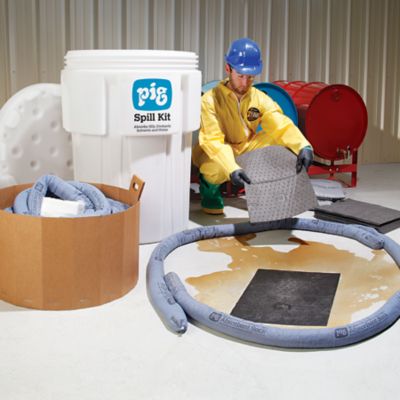Every facility should have an effective spill response plan to prevent accidents from becoming disasters. Stocking the appropriate spill response equi

Combining the correct equipment and training with a clear spill response guide ensures total preparedness. Assessing the risk, selecting the correct PPE equipment, confining the spill, stopping the source, evaluating the incident and implementing cleanup, decontaminating the site and completing required reports are all considered effective steps to take when responding to a spill.
However, it is important for companies to build their own procedures into these steps, including things like designating areas where spill response equipment is kept, determining a spill response team, recording the liquids and containers that are involved and developing internal reporting procedures. Every company will have a unique plan for their location.
New Pig and Spill Response
Industry thrives on fluids. They are required to create products, lubricate machines, cool parts and to perform a variety of other tasks. It is inevitable that spills will happen, but with effective preparation and the correct equipment they can be controlled and costly accidents can be avoided.
Since 1985, New Pig has been providing innovative products and services to industrial, institutional and governmental facilities. We’ve grown into a multi-channel, multi-brand supplier of products designed specifically for leak-and-spill management, industrial safety and plant maintenance.
Keeping PIG Spill Kits on hand is a great first step toward effective spill preparedness, and for enabling quick spill response. PIG Spill Kits are packed to aid fast response and ensure immediate access as spills can happen when we least expect them. Identifying the worst possible spill scenario will enable companies to cover all bases and stock the correct size of Spill Kit, and knowing this potential helps a facility determine what tools and equipment will be needed for proper response.
When spills happen
Although Spill response plans are specific to a facility, New Pig have identified 7 steps that will ensure effective spill response:
- Assess the risk
- Select personal protective equipment
- Confine the spill
- Stop the source
- Evaluate the incident and implement cleanup
- Decontaminate the site
- Complete required report
These steps along with the correct equipment and training will ensure that spill response is both fast and effective.
1. Assess the risk
From the moment a spill occurs and throughout response, responders should determine the risks that may affect human health, the environment and property. This could be instant because you know the liquid spilled because you were working with it, or it may involve some investigation. The spilled material can be identified from the container label or the Safety Data Sheet (SDS).
Next, identify how much has been spilled and the primary dangers posed to the spill responders and the environment. Once the extent of the spill and the risks are understood, appropriate measures may need to be taken to isolate the spill area (e.g. setting up exclusion zones).
2. Select personal protective equipment (PPE)
The spill responder may already be wearing the necessary PPE because they were working with the spilled liquid, but if not, it is crucial that the appropriate PPE is chosen. Consulting the SDS, Chemical Manufacturers literature or the PPE Manufacturers literature can aid in choosing. If the danger is uncertain and the material is unknown, the worst should be assumed and the highest level of protection used.
New Pig does not supply PPE in their spill kits because the chemicals and liquids companies are responding to and sizes of personnel vary widely. PPE should be specifically chosen by the company using it so that the appropriate protection is chosen.
3. Confine the spill
Confining the spill may be a simple task for spills of a few litres or it could be more difficult for larger spills, so it is important to make sure that the correct absorbents and size of spill kit are available for the liquids that have been spilled. PIG Universal Absorbents absorb oils, coolants, solvents and water; PIG Oil-Only Absorbents soak up oil not water; PIG HazMat absorbents absorb most acids, caustics or unknown liquids. PIG Spill Kits come in a variety of sizes to accommodate both large and small spills.
Once the correct absorbents or kits have been chosen, responders should limit the spill area by blocking, diverting, or confining the spill. New Pig non-absorbent barriers such as our SpillBlocker Dike or a PIG Conical Drain Plug help to do so. The flow of the liquid should also be stopped before it has a chance to contaminate a water source – minimising the spill area and protecting drains are the priorities. Make sure the barrier is placed far enough away from the spill to ensure you can complete the setup but also far away from sensitive areas, such as drains and waterways.
4. Stop the source
This step may happen before the spill is even confined depending on the extent or the size of the spill. This could simply involve turning a container upright, or plugging a leak from a damaged drum or container. PIG Multi-Purpose Epoxy Putty is an effective product for stopping leaks from punctured pipes or drums. Once the leak has been stopped the liquids should be transferred from the damaged container to a new one.
5. Evaluate the incident and implement cleanup
Once the spill is confined and the leak has been stopped, it is time to reassess the incident and develop a plan of action for implementing the spill cleanup. First, responders should make sure they have enough spill response supplies to deal with the incident. Enough PIG Pillows and PIG Mat Pads should be used to quickly absorb the spill and should be placed throughout the confined spill area. Additional PIG Products can also be used such as vacuums, pumps and containers. Once the absorbents are saturated, they may be considered hazardous waste and should be disposed of properly.
6. Decontaminate
The site, personnel, and equipment should be decontaminated by removing or neutralising the hazardous materials that have accumulated during the spill. This may involve removing and disposing of contaminated media, such as soil, that was exposed during the spill incident. PPE may be able to be reused after inspection and cleanup. An effective decontamination area should also be created to ensure the health and safety of emergency responders.
7. Complete required reports
As soon as possible after the spill, all spill notifications and reports required by local and national guidelines should be completed. Failure to do so can result in severe penalties. Typical reports include medical reports, local council or district reports, Environment Agency reports and company safety reports.
The steps above are simply a guide for companies to follow when responding to spills. They do not constitute a spill response plan in themselves, but together they provide a framework for companies to build a customized plan. Taking these steps will help companies be more prepared and able to respond effectively to unexpected spills.
Find out more:
New Pig provide a comprehensive range of Spill Kits from our online shop. Or why not give us a call on 0800 919 900.






COMMENTS